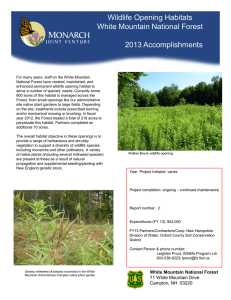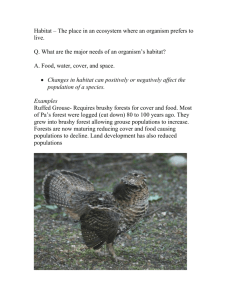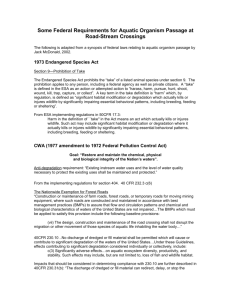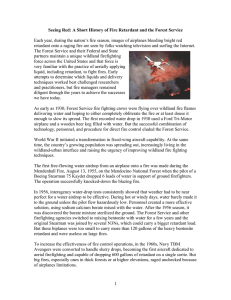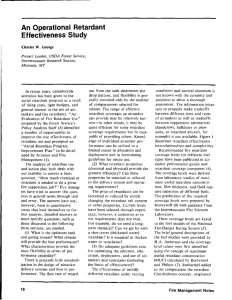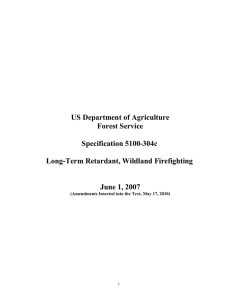National Retardant NEPA USFWS Reasonable and Prudent Alternative (RPA) Tracking Sheet
advertisement
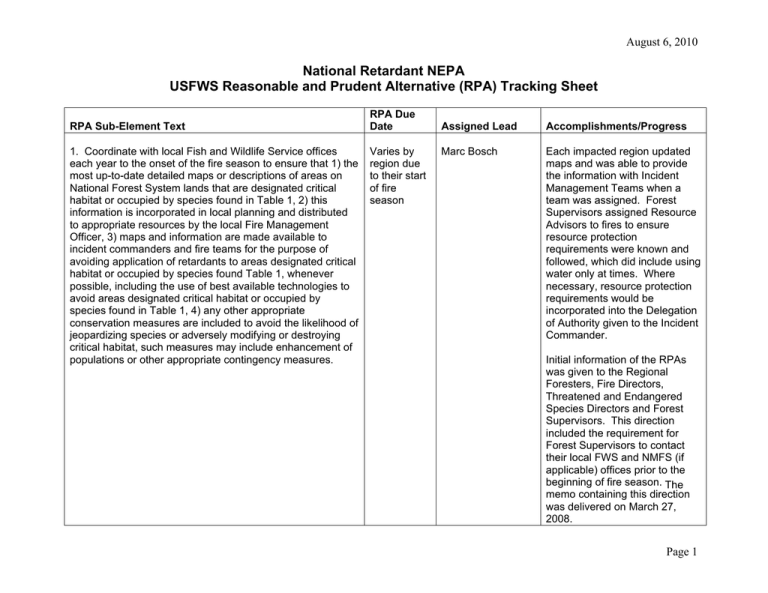
August 6, 2010 National Retardant NEPA USFWS Reasonable and Prudent Alternative (RPA) Tracking Sheet RPA Sub-Element Text 1. Coordinate with local Fish and Wildlife Service offices each year to the onset of the fire season to ensure that 1) the most up-to-date detailed maps or descriptions of areas on National Forest System lands that are designated critical habitat or occupied by species found in Table 1, 2) this information is incorporated in local planning and distributed to appropriate resources by the local Fire Management Officer, 3) maps and information are made available to incident commanders and fire teams for the purpose of avoiding application of retardants to areas designated critical habitat or occupied by species found Table 1, whenever possible, including the use of best available technologies to avoid areas designated critical habitat or occupied by species found in Table 1, 4) any other appropriate conservation measures are included to avoid the likelihood of jeopardizing species or adversely modifying or destroying critical habitat, such measures may include enhancement of populations or other appropriate contingency measures. RPA Due Date Varies by region due to their start of fire season Assigned Lead Accomplishments/Progress Marc Bosch Each impacted region updated maps and was able to provide the information with Incident Management Teams when a team was assigned. Forest Supervisors assigned Resource Advisors to fires to ensure resource protection requirements were known and followed, which did include using water only at times. Where necessary, resource protection requirements would be incorporated into the Delegation of Authority given to the Incident Commander. Initial information of the RPAs was given to the Regional Foresters, Fire Directors, Threatened and Endangered Species Directors and Forest Supervisors. This direction included the requirement for Forest Supervisors to contact their local FWS and NMFS (if applicable) offices prior to the beginning of fire season. The memo containing this direction was delivered on March 27, 2008. Page 1 August 6, 2010 A memo for 2009 has been sent to the field reminding them of the requirements with a revised reporting form. This information has been posted to both the Fire and Aviation’s web page and the Wildland Fire Chemical Systems web page. Each impacted forest has established pre-fire procedures that engage and incorporate USFWS personnel, developed maps, and identified areas where retardant would not be allowed. This information is shared with incident management teams where applicable. A memo will be sent to the field reminding them of the requirements with the reporting form. In addition the information has been included in the Interagency Fire and Aviation Standards for Operations and the Incident Pocket Response Guide. The memo was sent to the field May 2010. 2. Wherever practical, the Forest Service will prioritize fuels reduction projects for lands in the National Forest System that are in close vicinity to areas designated critical habitat or occupied by species listed in Table 1, so as to reduce the need to use aerially applied fire retardants. Ongoing Forest Supervisors The Decision Notice and RPAs were shared with the Regional Foresters through the March 27, 2008 letter. The Forest Supervisor has the responsibility to review the planned fuel treatments for prioritization based on the RPA as well as future treatments. Page 2 August 6, 2010 Forest Supervisors 3. Whenever practical, the Forest Service will use water or other less toxic fire retardants than those described in the proposed action within areas designated critical habitat or occupied by species in Table 1. Ongoing 4. If areas designated critical habitat or occupied by species found in Table 1 are exposed to fire retardant, then the Forest Service will initiate Emergency Consultation pursuant to regulations at 50 CFR 402.05 implementing section 7 of the Endangered Species Act of 1973, as amended. As part of the Emergency Consultation, the following measures may As required Forest Supervisors To monitor this nationally and report in 2009 the Washington Office will collect the information from the forests on what acres were treated in the identified areas. Beginning in FY2010 the National Fore Plan Operating and Reporting System (NFPORS) will be used to pull the data. The Washington Office pulled information from the reporting system for 2009 that provided information of 16,515 acres treated specifically within TES habitat listed, however numerous projects were completed near the TES species habitat. Included in the direction provided to an Incident Commander are any restrictions of tactics. Some areas did only allow water for aerially delivery, unless the situation of threat to life and property was so high. The direction will come in the form of the Delegation of Authority and the resource advisors direction. Direction to the field with a form for reporting retardant in waterways, 300 foot buffer, or T&E species habitat was sent on June 2. Any reports generated due to accidents, spills, and Page 3 August 6, 2010 apply: Conduct monitoring in coordination with the local Fish a. and Wildlife Service office of the direct, indirect, and cumulative impacts of the fire retardant application on listed species. Fish and Wildlife Service-approved monitoring protocols and reporting frequency will be developed. Monitoring for aquatic species may include water quality. b. If appropriate, and in consultation with the Fish and Wildlife Service, include measures to prevent or compensate for population declines due to application of fire retardant. c. During monitoring, all non-native plant species will be removed from areas of concern as appropriate for the area and listed species affected, as determined in consultation with the appropriate Fish and Wildlife Service office. Appropriate weed control methods will be developed in coordination with the local Fish and Wildlife Service office. exceptions to the Aerial Delivery of Retardant were submitted to our Wildland Fire Chemicals System program for consolidation and summarization. The Forest Supervisor would initiate the monitoring requirements where applicable. Initial reports submitted included if Section 7 consultation was initiated or not required, as well as monitoring. Forests use long-established local procedures for monitoring effects of activities to listed species and critical habitat, and for meeting and communication with their local USFWS personnel when needed to fully evaluate the significance of effects. On June 16-17, 2009 the FS and USGS met to develop the national template for protocols for monitoring in the event it is necessary. These protocols will be finalized and submitted to USFWS within the next few weeks. Once agreed upon the FS plans on piloting the protocols in 2009 if an opportunity exists to validate the process and data collection elements. Upon completion final protocols will be established and implemented nationally. Page 4 August 6, 2010 However each unit can still develop local procedures based on agreement with their USFWS office but they must meet the elements established in the RPA at a minimum. In addition the USGS has reviewed the biological opinion and are preparing a listing of surrogates for additional ammonia retardant testing that will be provided to the USFS. The FS met with USFWS in September 2009 to develop the process and data collection elements. The information presented was accepted however a national standard will only include the minimum requirements to allow the local units to incorporate specific needs. The USGS has created a Dispersal/Toxicity calculator that will be beta tested this season to determine if it is capturing the necessary information and will be used to support the degree of monitoring required. This information was sent to the field may 2010 for use this fire season. Page 5
